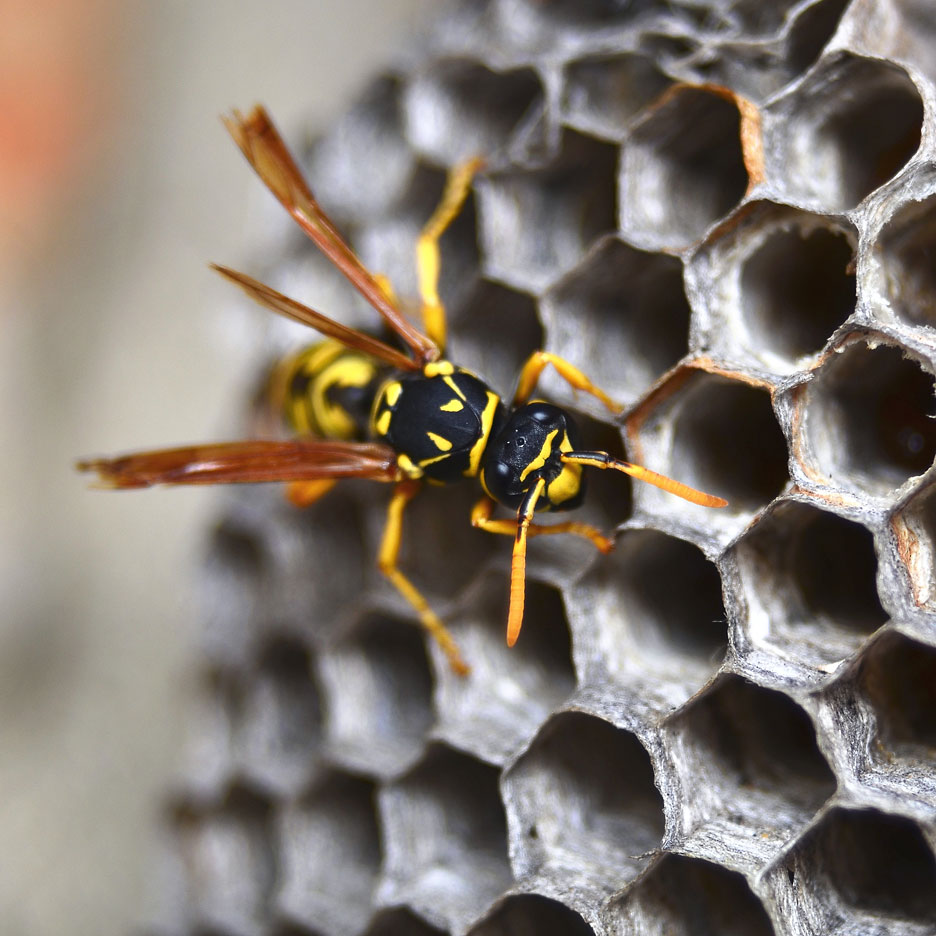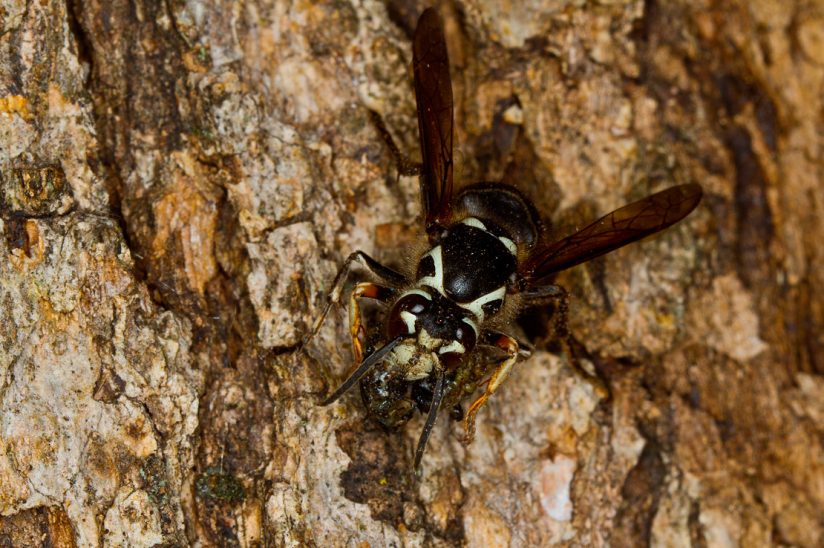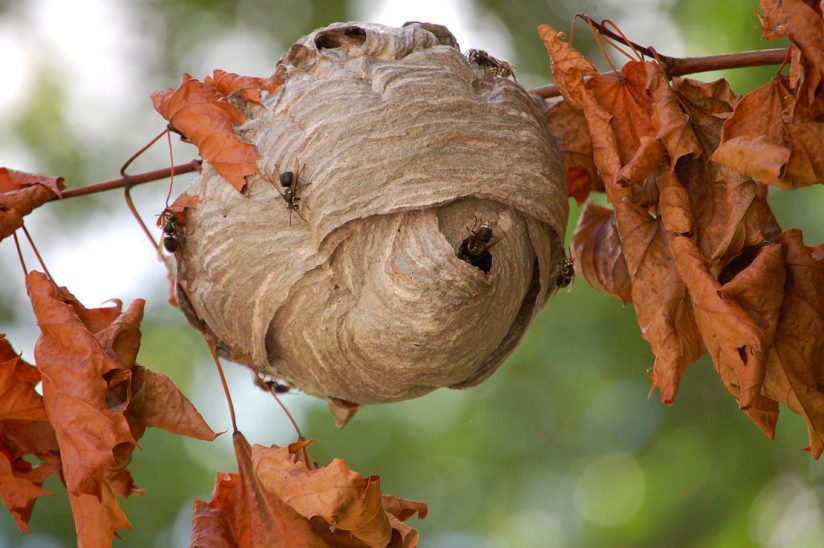Wasps
Several kinds of stinging wasps can pose serious health and safety threats to humans. Most problems occur when people are stung after getting too close to wasp nests constructed near homes, buildings and recreational areas. In such situations, it may be necessary to control the wasps, even though most wasps are beneficial pollinators and predators of other insects.
Although thousands of North American wasp species can “sting,” few are potentially dangerous to humans. Of the fewer than 40 species of stinging (vespid) wasps that occur in the United States, only a handful are important stinging pests in Texas. This publication reviews the most important and common species likely to be found around the home.
Kinds of Wasps. All wasps, bees and ants belong to the scientific order called Hymenoptera. The Hymenoptera comprise some of the most interesting and important insects, including many species that are beneficial predators and parasites of pest insects, and many useful pollinator species. Besides ants and bees, the most important stinging Hymenoptera belong to the wasp family Vespidae.
Most vespid wasps are social insects, living in nests that they build and defend cooperatively. The stinger of social wasps is primarily a defensive tool, designed to protect both nest and colony. However, when defending a colony, multiple wasp stings can occur quickly, with each wasp stinging one or more times. Vespid wasp nests are constructed of a paper-like material and may be found either above or below ground.
Another important group of wasps with stingers are the solitary wasps. The stinger of solitary wasps is used primarily for subduing prey. Although solitary wasps may be common and are often thought dangerous by people who fear wasps, solitary wasps rarely sting humans. Most are entirely beneficial, feeding on spiders, crickets, cicadas and caterpillars. Knowing how to distinguish between solitary and social wasps can be useful in determining whether control is justified.
Wasp Stings. Wasps sting their victims and inject venom from the rear of the abdomen (tail). The stinger in allwasps and bees is a modified egg-laying organ (ovipositor); hence only females can sting.
Venom from ant, bee and wasp stings is responsible for 40 to 100 deaths per year in the United States. Social wasp and bee venom contains more than 30 compounds, including biogenic amines, protein toxins and various enzymes. Most deaths from insect stings are the result of allergic reactions to venom proteins and enzymes.
Wasp stings typically result in intense pain, with swelling and redness at the site of the sting. Stings around the head, eyes and neck are especially serious. While pain is usually localized at the site of the sting, large local and systemic (allergic) reactions are also possible. Large local reactions occur when swelling and pain extends beyond two inches from the site of the sting. Swelling may involve an entire extremity, such as a hand, arm or leg. Large local reactions are usually not life-threatening, but may last for two to seven days. About 5 percent of people who experience a large local reaction will suffer an anaphylactic (serious systemic hypersensitivity) reaction if they are stung subsequently.
Systemic allergic reactions occur when symptoms are produced in body sites other than at the site of the sting. These reactions — anaphylaxis or anaphylactic reactions — range from a widespread rash, swelling and itching to difficulty breathing. In severe reactions, victims may develop a rapid pulse and low blood pressure, shock or respiratory distress and even death. Respiratory conditions account for more than half of all deaths due to Hymenoptera stings.
Anaphylaxis typically occurs within 20 to 30 minutes of a sting, although shock and death can occur as quickly as 10 to 15 minutes. It is critical to get someone experiencing a systemic reaction to emergency care immediately. If you know that you are allergic to bee or wasp venom, consult your physician to see
whether you should carry an epinephrine emergency kit or self-administer an antihistamine for life-saving purposes.
When Do Wasps Sting? Vespid wasps are most likely to sting when their nest is disturbed. All social wasps will vigorously defend their nests when disturbed. These wasps rarely sting away from the nest, unless trapped or pressed against the skin.
Wasps and bees are instinctively attracted to the upper bodies of animals, so in the event of an attack it is best to cover your head and run away quickly. The best defense is to run to a building, car or other protected place. Victims who stand in place and attempt to swat their attackers will continue to receive stings as the wasps summon reinforcements via chemical communication. Unlike honey bees, wasps do not leave a stinger in the skin and may sting repeatedly.
Solitary wasps, on the other hand, rarely sting unless mishandled or trapped against the skin. The venom of solitary wasps is different from that of social wasps and seldom causes more than momentary pain. Because solitary wasps do not build a community nest, they do not attempt to defend their nest.
Social Wasps
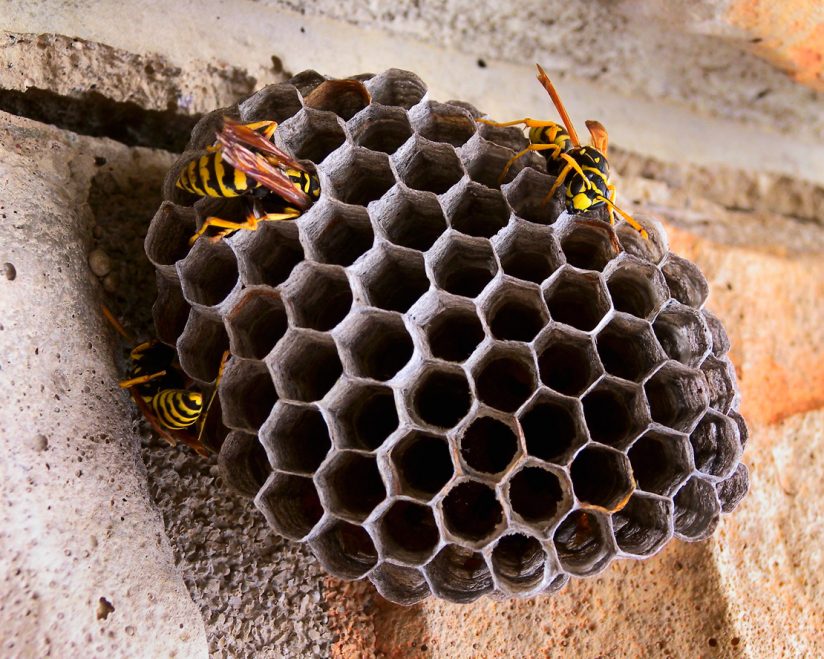
Paper wasps are one of the most common vespid wasps seen around homes and buildings. They are 3/4 to 1 inch long and generally reddish-orange to dark brown. They often have yellow body markings. Paper wasps have three castes — infertile female workers, which make up most of the wasps on nests during the summer; males; and queens. Males and new queens are produced primarily in late summer and fall. Unlike yellowjackets and hornets, the paper wasp queen is not much larger than the worker wasps. Paper wasps build their nests from chewed wood fibers. The comb, which hangs from a single filament, is usually oriented downward and consists of a single tier of hexagonal-shaped cells. Nests are most frequently seen under the eaves of houses but may also be found in attics, garages, storage sheds, barns, on shrubbery, trees and a variety of protected sites. The typical mature paper wasp nest contains 20 to 30 adults and rarely more than 200 cells.
Life cycle: Colonies are founded in the spring by queens that spend the winter in sheltered hiding places. Although early season queens may cooperate in founding a nest, by midsummer there is usually only one active egg-laying queen per nest. New nests are constructed every year, often in the same general location where nests were built the previous season.
Queen paper wasps lay a single egg per nest cell. The newly hatched paper wasp larva is white and legless. As it grows in size, it fills the nest cell. The queen, and later the workers, bring food to the larva. Eventually, the larva matures, the cell is closed and pupation occurs. After pupation, the adult wasp emerges by chewing through the paper cell cover.
During late summer and fall, males and queen paper wasps are produced. Males and females mate in the fall. The males then die, and fertilized queens enter sheltered locations for hibernation.
Overwintering paper wasp queens may join together, sometimes in large groups. They seem to prefer high structures, such as the peaked attics of houses, chimneys and tall buildings. During the winter, they frequently enter homes and offices, especially during warmer periods. Overwintering paper wasps are not aggressive and may be captured and released outdoors or killed with a fly swatter.
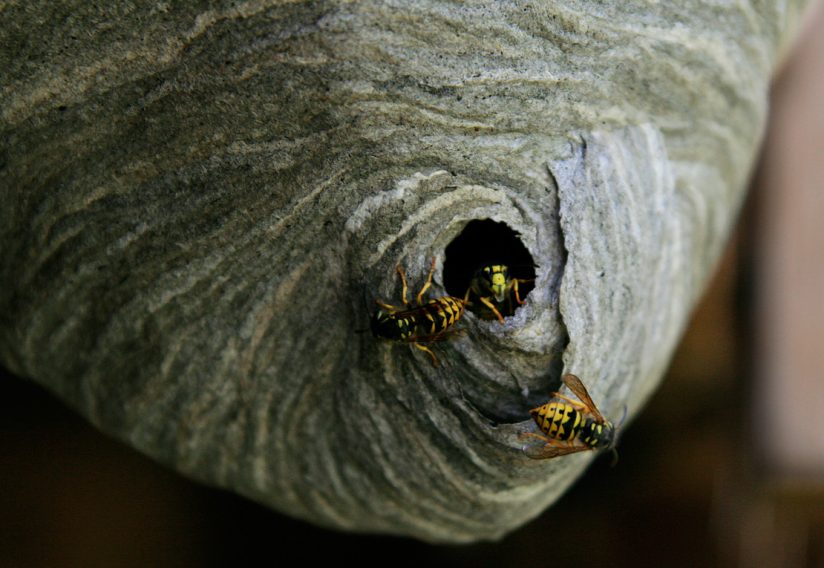
Yellowjackets are easily recognized but are often confused with paper wasps. Baldfaced hornets are also a type of yellowjacket wasp, but because of some behavioral differences, they will be discussed separately.
Worker yellowjackets construct their nests of a paper-like material consisting of wood fiber. Unlike paper wasp nests, they are completely enclosed in an envelope except for the entrance hole. In Texas, southern yellowjacket nest size may vary from a few inches to 6 feet or larger, and nests may contain up to 45 levels of combs and 20,000 adult workers. Yellowjackets are primarily ground nesters, but they also construct aerial nests. Subterranean nests may be found in gardens, flower beds, pastures, roadside embankments and elsewhere. Aerial nests are typically constructed in trees, under eaves, in wall voids of buildings, in open garages and storage sheds, on porches, in abandoned furniture and in other places that provide protection and are close to food and water. Because of their scavenging behavior, yellowjackets are a menace around parks, camps and suburban sites where people leave open food and discard garbage.
Yellowjacket workers forage to feed their larvae insects and spiders. They also gather nectar, honeydew and other carbohydrates, but they do not store honey as do bees.
Colony founding. Yellowjacket queens overwinter under loose bark, in cracks and crevices and occasionally in attics or similar sheltered locations. They emerge during the early spring and build small paper nests in which they lay eggs. When the eggs hatch, the queens feed the young larvae for about 18 to 20 days. After the first brood of workers emerge, the nest may rapidly expand up to a foot long or larger within a few days or weeks. Maximum colony size is attained by August or September. This is followed by the emergence of males and next year’s queens in October and November. After mating, the males die and inseminated queens usually seek sheltered places to overwinter, abandoning the nest. Abandoned nests rapidly decompose and are not reused the next year. Occasionally, in sheltered sites or during mild winters, the nest may not be abandoned. In such cases, so-called perennial colonies may be maintained by both queen(s) and workers into the following year. Perennial colonies are generally larger than annual colonies.
Hornets
The term hornet is often used in a general sense to describe many kinds of wasps and yellowjackets. Actually, the baldfaced hornet, Dolichovespula maculata, is the only “hornet” reported in Texas. Hornets construct a round or pear-shaped paper nest, up to 3 feet long. The grayish to brown nest has two to four horizontally arranged combs inside and an entrance hole near the bottom.
Hornet nests almost always are above ground, often high in trees. Occasionally, they may be attached to the eaves of buildings. A mature colony may contain 200 to 400 adults.
While the stings of hornets can be intensely painful, hornets are less likely to attack than paper wasps or yellowjacket wasps. Hornets typically nest high in trees or in other remote locations, where they pose no threat to humans and should be left undisturbed.
Solitary Wasps
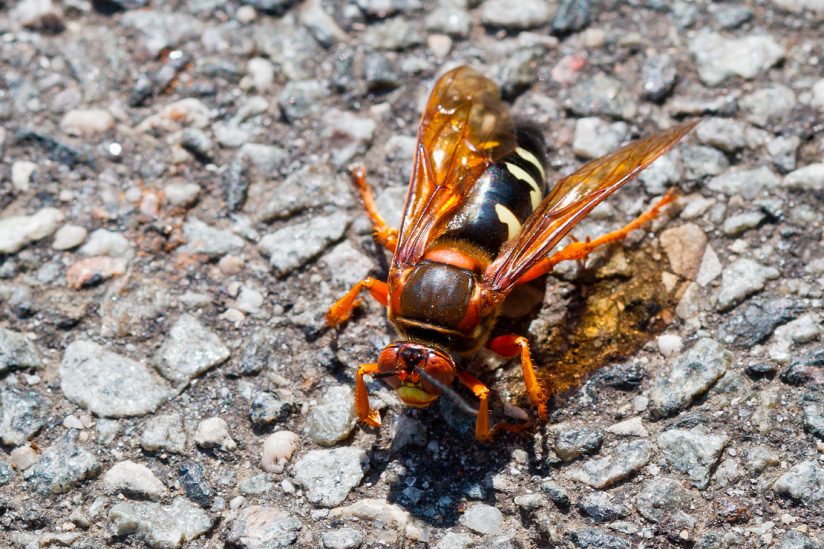
Cicada Killers. This large insect is 1 1/2 inches long, rusty red on the head, thorax and wings and striped with black and yellow on the abdomen. These wasps may be considered a nuisance in landscapes during times of the year when cicadas are present in shade trees. Cicada killer wasps appear formidable because of their size and behavior. Male cicada killers cannot sting but will buzz very near humans. Females will not sting unless handled but sometimes painfully sting people who are working on lawns or step on their nests barefooted. Female cicada killers dig galleries in lawns, gardens or flower beds, where they lay eggs and provision the young larvae with paralyzed cicadas. This nesting activity may damage lawns or vegetable gardens. Control is rarely warranted for this otherwise beneficial insect. When control is necessary, sprinkle about 1 tablespoon of carbaryl dust into the gallery hole and tamp the entrance shut.
Cricket Hunter Wasps
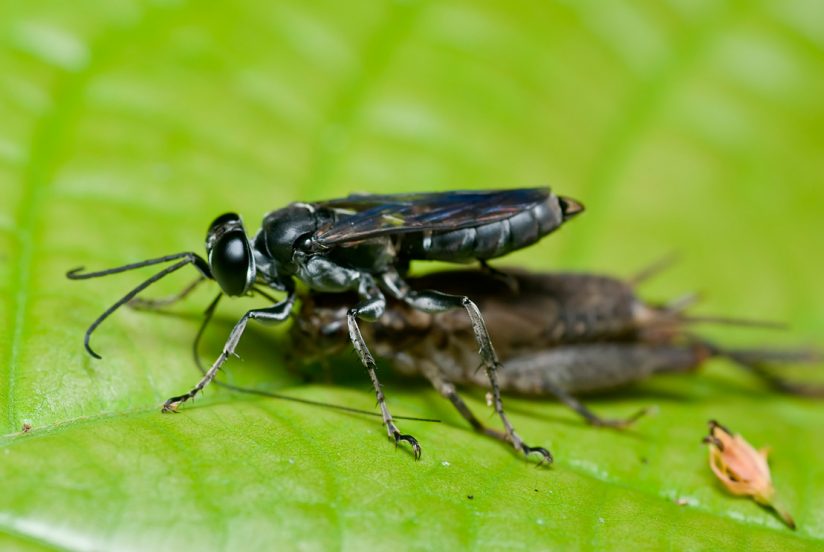
Cricket hunter wasps in the genus Liris are occasional indoor pests in Texas. These solitary wasps are 1/2 to 5/8 inches long and dull black with dusky-colored wings. They spend much of their time searching for crickets, which they attempt to sting, capture and transport live to an underground hole. After a cricket has been collected, the female lays a single egg on the victim. The larva that hatches eventually develops into an adult wasp.
Little is known about these insects. In urban areas, cricket-hunter wasps may nest under or in the walls of buildings. When this happens, the offspring of nest-building females may emerge into indoor rooms. Because numerous crickets may be provisioned within a wall void as described above, few or many wasps may emerge indoors. In one case, more than 100
wasps were counted from a single bathroom, apparently emerging from a slab opening under a bathtub.
Cricket-hunter wasps are seen most commonly indoors during warm weather spells in the winter or early spring. Infestations can be persistent and annoying. Though not normally aggressive, they can sting if provoked.
The best solution is prevention. Fill any holes or cracks in soil that might lead under the home. Seal openings, such as weep holes, that might provide access to wall voids. Ventilation weep holes should be screened rather than caulked. Other cracks and gaps in walls should be sealed with expanding foam, mortar or other appropriate material. In severe cases, wall voids may be treated with pesticide aerosols or dusts; however, there is little evidence that this treatment works consistently. Adult wasps can be safely killed with a fly swatter or captured and released outdoors.
Mud Daubers
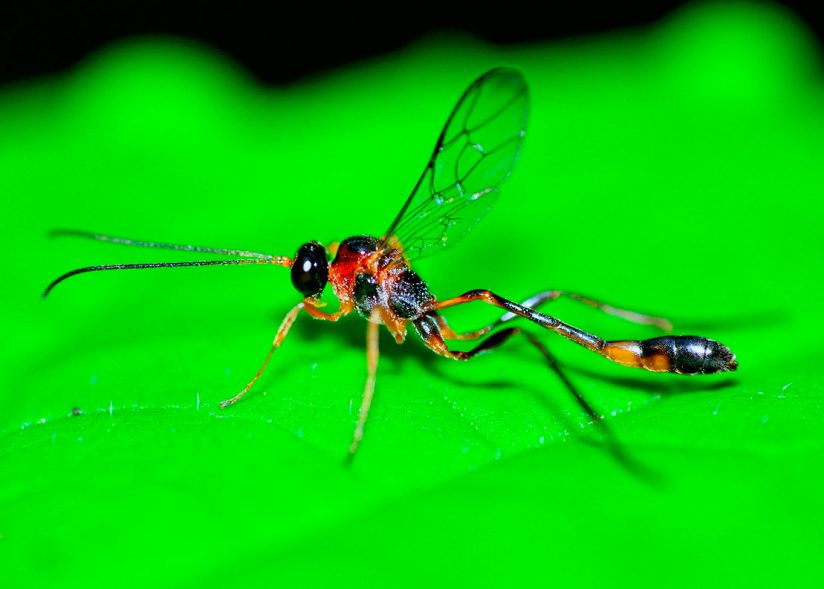
These wasps build small, tube-like nests of mud under eaves, in attics and under the roofs of storage buildings. Adult mud daubers are 3/4 to 1 inch long and vary from dull black with bright yellow markings to blackish or iridescent blue-black. They have longer, more slender waists than most other wasps. As they develop in the mud tubes, young larvae are generally fed spiders, including the poisonous brown recluse.
Control. Since females do not defend their nests, mud daubers structures can simply be removed by hand with a putty knife.
